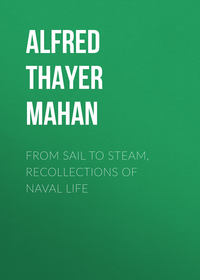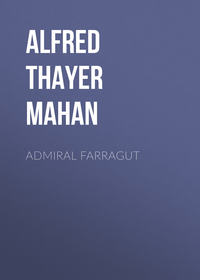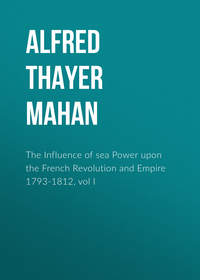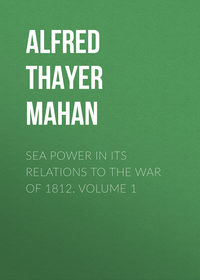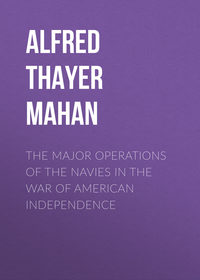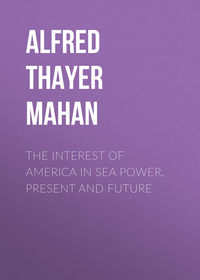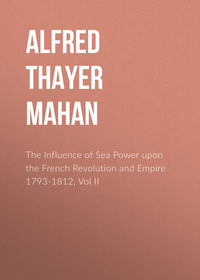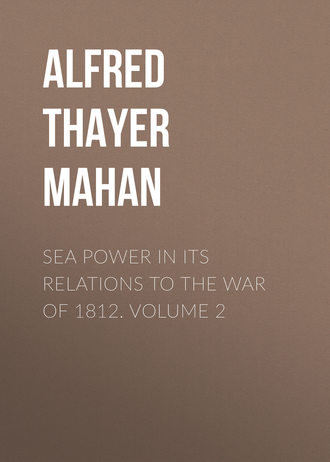 полная версия
полная версияSea Power in its Relations to the War of 1812. Volume 2
Although the United States was not in formal alliance with France, the common hostility made the ports of either nation a base of operations to the other, and much facilitated the activities of American cruisers in British seas. One of the most successful of the privateers, the "True Blooded Yankee," was originally equipped at Brest, under American ownership, though it does not appear whether she was American built. On her first cruise her prizes are reported at twenty-seven. She remained out thirty-seven days, chiefly off the coast of Ireland, where she is said to have held an island for six days. Afterwards she burned several vessels in a Scotch harbor. Her procedure illustrates the methods of privateering in more respects than one. Thus, two large ships, one from Smyrna and one from Buenos Ayres, were thought sufficiently valuable to attempt sending into a French port, although the enemy watched the French coast as rigorously as the American. The recapture of a third, ordered to Morlaix, received specific mention, because one of the prize crew, being found to be an Englishman, was sentenced to death by an English court.224 Eight others were destroyed; and, when the privateer returned to port, she carried in her own hold a miscellaneous cargo of light goods, too costly to risk in a less nimble bottom. Among these are named eighteen bales of Turkey carpets, forty-three bales of raw silk, seventy packs of skins, etc.225 The "True Blooded Yankee" apparently continued to prefer European waters; for towards the end of 1814 she was taken there and sent into Gibraltar.
While there were certain well-known districts, such as these just mentioned, and others before specified, in which from causes constant in operation there was always to be found abundant material for the hazardous occupation of the commerce-destroyer, it was not to them alone that American cruisers went. There were other smaller but lucrative fields, into which an occasional irruption proved profitable. Such were the gold-coast on the west shore of Africa, and the island groups of Madeira, the Canaries, and Cape Verde, which geographically appertain to that continent. Thither Captain Morris directed the frigate "Adams," in January, 1814, after first escaping from his long blockade in the Potomac. This voyage, whence he returned to Savannah in April, was not remunerative; his most valuable prize, an East India ship, being snatched out of his hands, when in the act of taking possession, by an enemy's division in charge of a convoy of twenty-five sail, to which probably she had belonged, and had been separated by the thick weather that permitted her capture.226 A year before this the privateer "Yankee," of Bristol, Rhode Island, had had better success. When she returned to Narragansett Bay in the spring of 1813, after a five months' absence, she reported having scoured the whole west coast of Africa, taking eight vessels, which carried in the aggregate sixty-two guns, one hundred and ninety-six men, and property to the amount of $296,000. In accordance with the practice already noticed, of distributing the spoil in order better to insure its arrival, she brought back in her own hold the light but costly items of six tons of ivory, thirty-two bales of fine goods, and $40,000 in gold-dust.227 This vessel was out again several times; and when the war closed was said to have been the most successful of all American cruisers. Her prizes numbered forty, of which thirty-four were ships or brigs; that is, of the larger classes of merchantmen then used. The estimated value of themselves and cargoes, $3,000,000, is to be received with reserve.228
It was in this neighborhood that the privateer schooner "Globe," Captain Moon, of Baltimore, mounting eight 9-pounder carronades and one long gun, met with an adventure illustrative of the fighting incidental to the business. To this the privateersmen as a class were in no wise loath, where there was a fair prospect of the gain for which they were sent to look. Being off Funchal, in the island of Madeira, November 1, 1813, two brigs, which proved to be English packets, the "Montague" and "Pelham," were seen "backing and filling;" that is, keeping position in the open roadstead which constitutes the harbor, under sail, but not anchored. Packets, being in government service, were well armed for their size, and as mail carriers were necessarily chosen for speed; they therefore frequently carried specie. In one taken by the "Essex," Captain Porter found $55,000, which as ready cash helped him much to pay his frigate's way in a long and adventurous career. It does not appear that the "Globe" at first recognized the character of these particular vessels; but she lay-by during the night, watching for their quitting the shelter of neutral waters. This they did at 9 P.M., when the privateer pursued, but lost sight of them in a squall. The next morning they were seen in the southwest, and again chased. At 10.15 A.M. the "Montague" began firing her stern guns. The schooner replied, but kept on to board, knowing her superiority in men, and at 12.30 ran alongside (1). The attack being smartly met, and the vessels separating almost immediately, the attempt failed disastrously; there being left on board the packet the two lieutenants of the "Globe" and three or four seamen. Immediately upon this repulse, the "Pelham" crossed the privateer's bow and raked her (P 2), dealing such destruction to sails and rigging as to leave her unmanageable. The "Montague" and "Globe" now lay broadside to broadside (2), engaging; and ten minutes later the "Montague" by her own report was completely disabled (M 3). Captain Moon claimed that she struck; and this was probably the case, if his further incidental mention, that the mailbags were seen to be thrown overboard, is not a mistake. The action then continued with the "Pelham," within pistol-shot (3), for an hour or so, when the schooner, being found in a sinking condition, was compelled to haul off; "having seven shot between wind and water, the greater part of our standing and running rigging shot away, and not a sail but was perfectly riddled and almost useless." After separating, the several combatants all steered with the tradewinds for the Canaries; the British going to Teneriffe, and the American to the Grand Canary.229
From the injuries received, it is apparent that, for the armaments of the vessels, this was a very severe as well as determined engagement. The British had six killed and twelve wounded; the American five killed and thirteen wounded, besides the prisoners lost in boarding. All three captains were severely hurt, that of the "Montague" being killed. The figures given are those reported by each side; how exaggerated the rumors current about such encounters, and the consequent difficulty to the historian, is shown by what each heard about the other's casualties. A Spanish brig from Teneriffe told Moon that the enemy had twenty-seven men killed; while the British were equally credibly informed that the "Globe" lost thirty-three killed and nineteen wounded.
Near about this time, in the same neighborhood of Madeira, the privateer schooner "Governor Tompkins," of New York, captured in rapid succession three British merchant vessels which had belonged to a convoy from England to Buenos Ayres, but after its dispersal in a gale were pursuing their route singly. Two of these reached an American port, their bulky and heavy ladings of dry goods and hardware not permitting transfer or distribution. The sale of one cargo realized $270,000.230 At about the same moment came in a brig of like value, not improbably another wanderer from the same group, captured near Madeira by the ship "America," of Salem. This vicinity, from the islands to the equator, between 20° and 30° west longitude, belongs essentially to the thronged highway and cross-roads of commerce, which has been noted as a favorite cruising ground of American ships of war. Hereabouts passed vessels both to and from the East Indies and South America. The bad luck of several frigates, and the rough handling of the "Globe" by the packets, illustrate one side of the fortune of war, as the good hap of the "America" and "Governor Tompkins" shows the other.

Diagram of the Montague, Pelham, Globe battle
It is, however, the beginnings and endings of commercial routes, rather than the intermediate stretch, which most favor enterprises against an enemy's trade. In the thronging of vessels, the Caribbean Sea, with its teeming archipelago, was second only, if second, to the waters surrounding the United Kingdom. England was one extremity, and the several West India Islands the other, of a traffic then one of the richest in the world; while the tropical articles of this exchange, if not absolute necessaries of life, had become by long indulgence indispensable to the great part of civilized mankind. Here, therefore, the numbers, the efforts, and the successes of American privateers most nearly rivalled the daring achievements of their fellows in the Narrow Seas and the approaches to Great Britain and Ireland. The two regions resembled each other in another respect. Not only was there for both an external trade, mainly with one another, but in each there was also a local traffic of distribution and collection of goods, from and to central ports, in which was concentrated the movement of import and export. As has been remarked concerning the coastwise carriage of the United Kingdom, this local intercourse, to be efficient, could not be regulated and hampered to the same extent as the long voyage, over-sea, transportation. A certain amount of freedom and independence was essential, and the risk attendant upon such separate action must be compensated, as far as might be, by diminishing the size of the vessels engaged; a resource particularly applicable to the moderate weather and quiet seas prevalent in the tropics.
Both the exposure of trade under such relaxed conditions, and the relative security obtained by the convoy system, rigidly applied, are shown by a few facts. From September 1, 1813, to March 1, 1814, six months, the number of prizes taken by Americans, exclusive of those on the Lakes, was reported as two hundred and seventy. Of these, nearly one third—eighty-six—were to, from, or within the West Indies. Since in many reports the place of capture is not given, nor any data sufficient to fix it, it is probable that quite one third belonged to this trade. This evidences the scale, both of the commerce itself and of its pursuers, justifying a contemporary statement that "the West Indies swarm with American privateers;" and it suggests also that many of the seizures were local traders between the islands, or at least vessels taking their chance on short runs. On the other hand, the stringency with which the local officials enforced the Convoy Act was shown, generally, by the experience at this time of the United States naval vessels, the records of which, unlike those of most privateers, have been preserved by filing or publication; and, specifically, by a number of papers found in a prize by the United States frigate "Constitution," Captain Charles Stewart, while making a round of these waters in the first three months of 1814. Among other documents was a petition, signed by many merchants of Demerara, praying convoy for fifty-one vessels which were collected and waiting for many weary weeks, as often had to be done. In one letter occurs the following: "With respect to procuring a license for the "Fanny" to run it, in case any other ships should be about to do so, we do not believe that, out of forty vessels ready to sail, any application has been made for such license, though out of the number are several out-port vessels well armed and manned. Indeed, we are aware application would be perfectly useless, as the present Governor, when at Berbice, would not permit a vessel from that colony to this [adjoining] without convoy. If we could obtain a license, we could not justify ourselves to shippers, who have ordered insurance with convoy."231
The expense and embarrassment incident to such detentions are far-reaching, and the effects are as properly chargeable as are captures themselves to the credit of the cruisers, by the activity of which they are occasioned. The "Constitution" could report only four prizes as the result of a three months' cruise, necessarily shortened by the approach of spring. This made it imperative for a vessel, denied admission to most home ports by her draught of water, to recover the shelter of one of them before the blockade again began, and the exhaustion of her provisions should compel her to attempt entrance under risk of an engagement with superior force. As it was, she was chased into Salem, and had to lighten ship to escape. But Stewart had driven an enemy's brig of war into Surinam, chased a packet off Barbados, and a frigate in the Mona Passage; and the report of these occurrences, wherever received, imposed additional precaution, delay, and expense.
At the same time that the "Constitution" was passing through the southern Caribbean, the naval brigs "Rattlesnake" and "Enterprise" were searching its northern limits. These had put out from Portsmouth, New Hampshire, when the winter weather drove the blockaders from there, as from Boston, whence the "Constitution" had sailed. Starting early in January, 1814, these two light cruisers kept company, passing east of Bermuda to the island of St. Thomas, at the northeast corner of the Caribbean. Thence they turned west, skirting the north shores of Porto Rico and Santo Domingo as far as the Windward Passage. Through this they entered the Caribbean, followed the south coast of Cuba, between it and Jamaica, rounded Cape San Antonio, at its western extremity, and thence, traversing the Straits of Florida, returned along the coast of the United States. Having already been chased twice in this cruise, they were compelled by a third pursuer to separate, February 25. The stranger chose to keep after the "Enterprise," which being a very dull sailer was obliged in a flight of seventy hours to throw overboard most of her battery to escape. The two put into Wilmington, North Carolina, a port impracticable to a frigate.232
In this long round the brigs overhauled eleven vessels, two only of which were under the British flag. Two were Americans; the rest neutrals, either Swedes or Spaniards. Of the two enemies, only one was a merchant ship. The other was a privateer, the chase of which gave rise to a curious and significant incident. Being near the Florida coast, and thinking the brigs to be British, twenty or thirty of the crew took to the boats and fled ashore to escape anticipated impressment. As Marryat remarks, a British private vessel of that day feared a British ship of war more than it did an enemy of equal force. Of the neutrals stopped, one was in possession of a British prize crew, and another had on board enemy's goods. For these reasons they were sent in for adjudication, and arrived safely. Judged by these small results from the several cruises of the "Enterprise," "Rattlesnake," and "Constitution," the large aggregate of captures before quoted, two hundred and seventy, would indicate that to effect them required a great number of cruisers, national and private. That this inference is correct will be shown later, by some interesting and instructive figures.
While the making of prizes was the primary concern of the American privateers, their cruises in the West Indies, as elsewhere, gave rise to a certain amount of hard fighting. One of the most noted of these encounters, that of the schooner "Decatur," of Charleston, with the man-of-war schooner "Dominica," can hardly be claimed for the United States; for, though fought under the flag, her captain, Diron, was French, as were most of the crew. The "Dominica" was in company with a King's packet, which she was to convoy part of the way to England from St. Thomas. On August 5, 1813, the "Decatur" met the two about three hundred miles north of the island. The British vessel was superior in armament, having fifteen guns; all carronades, except two long sixes. The "Decatur's" battery was six carronades, and one long 18-pounder. For long distances the latter was superior in carrying power and penetration to anything on board the "Dominica;" but the American captain, knowing himself to have most men, sought to board, and the artillery combat was therefore mainly at close quarters, within carronade range. It began at 2 P.M. At 2.30 the schooners were within half-gunshot of one another; the "Dominica" in the position of being chased, because of the necessity of avoiding the evident intention of the "Decatur" to come hand to hand. Twice the latter tried to run alongside, and twice was foiled by watchful steering, accompanied in each case by a broadside which damaged her rigging and sails, besides killing two of her crew. The third attempt was successful, the "Decatur's" bow coming against the quarter of the "Dominica," the jib-boom passing through her mainsail. The crew of the privateer clambered on board, and there followed a hand-to-hand fight equally honorable to both parties. The British captain, Lieutenant Barretté, a young man of twenty-five, who had already proved his coolness and skill in the management of the action, fell at the head of his men, of whom sixty out of a total of eighty-eight were killed or wounded before their colors were struck. The assailants, who numbered one hundred and three, lost nineteen. The packet, though armed, took no part in the fight, and when it was over effected her escape.233 The "Decatur" with her prize reached Charleston safely, August 20; bringing also a captured merchantman. The moment of arrival was most opportune; two enemy's brigs, which for some time had been blockading the harbor, having left only the day before.
In March, 1814, the privateer schooner "Comet," of Baltimore, not being able to make her home port, put into Wilmington, North Carolina. She had been cruising in the West Indies, and had there taken twenty vessels, most of which were destroyed after removing valuables. In the course of her operations she encountered near St. Thomas the British ship "Hibernia;" the size of which, and her height above the water, by preventing boarding, enabled her successfully to repel attack, and the privateer was obliged to haul off, having lost three men killed and thirteen wounded. The American account of this affair ascribes twenty-two guns to the "Hibernia." The British story says that she had but six, with a crew of twenty-two men; of whom one was killed and eleven wounded. The importance of the matter in itself scarcely demands a serious attempt to reconcile this discrepancy; and it is safer to accept each party's statement of his own force. The two agree that the action lasted eight or nine hours, and that both were much cut up. It is evident also from each narrative that they lay alongside most of the time, which makes it probable that the ship's height saved her from being overborne by superior numbers.
The "Saucy Jack," of Charleston, passed through several severe combats, in one of which she was even worse mauled than the "Comet" in the instance just cited. On April 30, 1814, off St. Nicolas Mole, in the Windward Passage between Cuba and Santo Domingo, she met the British ship "Pelham," a vessel of five hundred and forty tons, and mounting ten guns, bound from London to Port au Prince. The "Pelham" fought well, and the action lasted two hours, at the end of which she was carried by boarding. Her forty men were overpowered by numbers, but nevertheless still resisted with a resolution which commanded the admiration of the victors. She lost four killed and eleven wounded; among the latter her captain, dangerously. The privateer had two killed and nine wounded. Both vessels reached Charleston safely, and the "Saucy Jack" at once fitted out again. It is told that, between daylight and dark of the day she began to enlist, one hundred and thirty able-bodied seamen had shipped; and this at a time when the navy with difficulty found crews.234
The "Saucy Jack" returned to the West Indies for another cruise, in which she encountered one of those rude deceptions which privateers often experienced. She had made already eight prizes, for one of which, the ship "Amelia," she had had to fight vigorously, killing four and wounding five of the enemy, while herself sustaining a loss of one killed and one wounded, when on October 31, 1814, about 1 A.M., being then off Cape Tiburon at the west end of Haïti, she sighted two vessels standing to the westward. Chase was made, and an hour later the privateer opened fire. The strangers replied, at the same time shortening sail, which looked ominous; but the "Saucy Jack," willing to justify her name, kept on to close. At 6 A.M., having arrived within a few hundred yards, the enemy were seen to be well armed, but appeared not to be well manned. At seven, by which time it was daylight, the "Saucy Jack" began an engagement with the nearer, and ten minutes later ran her alongside, when she was found to be full of soldiers. The privateer sheered off at once, and took to her heels, followed by an incessant fire of grape and musketry from those whom she had recently pursued. This awkward position, which carried the chance of a disabling shot and consequent capture, lasted till eight, when the speed of the schooner took her out of range, having had in all eight men killed and fifteen wounded; two round shot in the hull, and spars and rigging much cut up. It was afterwards ascertained that her opponent was the "Volcano" bombship, convoying the transport "Golden Fleece," on board which were two hundred and fifty troops from Chesapeake Bay for Jamaica. The "Volcano" lost an officer and two men killed, and two wounded; proving that under somewhat awkward circumstances the "Saucy Jack" could give as well as take.235
A little later in this season a group of nine sail, from the West Indies for Europe, was encountered by the privateer "Kemp," of Baltimore, broad off the coast of North Carolina. Excluded, like the "Comet" and others, from return to the port where she belonged, the "Kemp" had been in Wilmington, which she left November 29, 1814; the strangers being sighted at 8 A.M. December 1. One was a convoying frigate, which, when the "Kemp" pursued, gave chase and drove her off that afternoon. The privateer outran her pursuer, and during the night by devious courses gave her the slip; thereupon steering for the position where she judged she would again fall in with the merchant vessels. In this she was successful, at daylight discovering them,—three ships, three brigs, and two schooners. At 11 A.M. one ship was overtaken, but proving to be Spanish, from Havana to Hamburg, was allowed to proceed, while the "Kemp" again followed the others. At noon they were five miles to windward, drawn up in a line to fight; for in those days of war and piracy most merchant ships carried at least a few guns for defence, and in this case their numbers, combined in mutual support, might effect a successful resistance. At two they took the initiative, bearing down together and attacking. The "Kemp" engaged them all, and in half an hour the untrained squadron was naturally in confusion. One after the other, six of the seven were boarded, or without waiting to be attacked struck their colors as the schooner drew up; but while four were being taken into possession, the two others seized the opportunity and made off. Two ships and two brigs remained in the hands of the captor. All were laden with sugar and coffee, valuable at any time, but especially so in the then destitute condition of the United States. After this unusual, if not wholly unique, experience, the "Kemp" returned to port, having been absent only six days. Her prisoners amounted to seventy-one, her own crew being fifty-three. The separation of the escort from the convoy, the subsequent judicious search for the latter, and the completeness of the result, constitute this a very remarkable instance of good management accompanied by good fortune; success deserved and achieved.236
The privateer brig "Chasseur," of Baltimore, Captain Thomas Boyle, was one of the typically successful and renowned cruisers of the time. She carried a battery of sixteen 12-pounder carronades, and in the course of the war thirty prizes are credited to her. In the late summer of 1814 she cruised off the coast of Great Britain and Ireland, returning at the end of October; having made eighteen captures during an absence of three months. From these she paroled and sent in by cartels one hundred and fifty prisoners, bringing back with her forty-three, of whom she had not been able thus to rid herself.237 After refitting she went to the West Indies for a winter cruise, which extended from the Windward Islands to the neighborhood of Havana. Here she signalized the approaching end of her career by an action, fought after peace not only had been concluded at Ghent, but already was known in the United States. On February 26, 1815, at 11 A.M., being then twenty miles east of Havana, and six miles from the Cuban coast, a schooner was seen in the northeast (1), running down before the northeast trade-wind. Sail was made to intercept her (2), there being at the time visible from the "Chasseur's" masthead a convoy lying-to off Havana, information concerning which probably accounts for her presence at this spot. The chase steered more to the northward (2), bringing the wind on her starboard side, apparently wishing to avoid a meeting. The "Chasseur" followed her motions, and when within about three miles the stranger's foretopmast went over the side, showing the press of sail she was carrying. After clearing the wreck she hauled close on the wind, heading northerly. At 1 P.M., she began to fire her stern gun and showed British colors; but only three port-holes were visible on her port side,—towards the "Chasseur."




